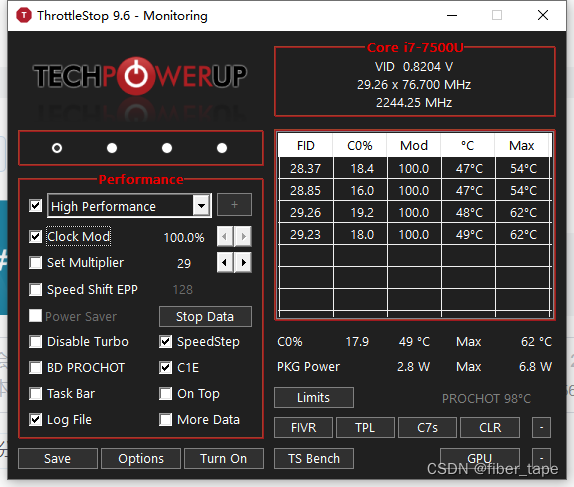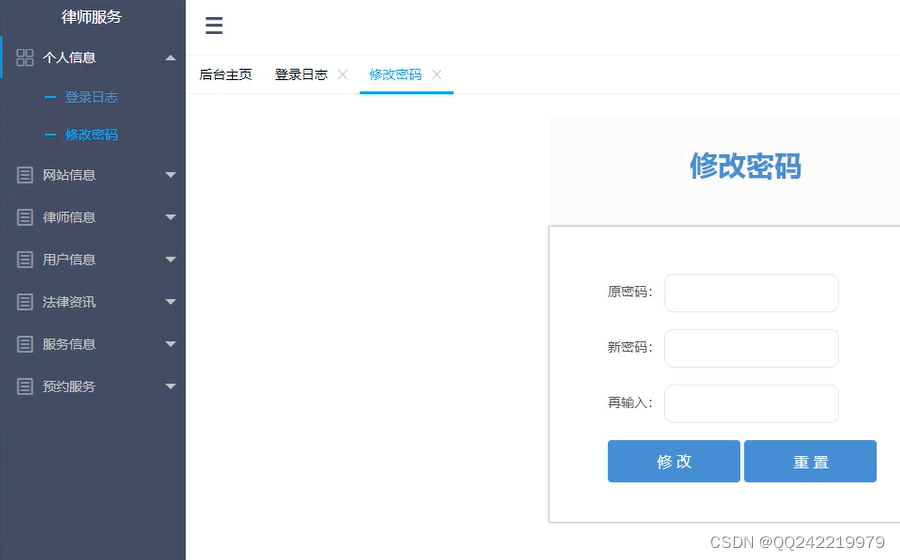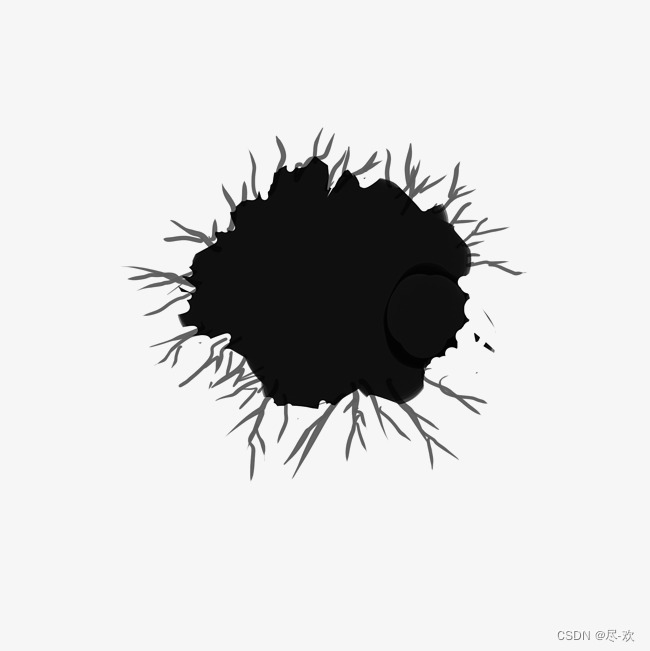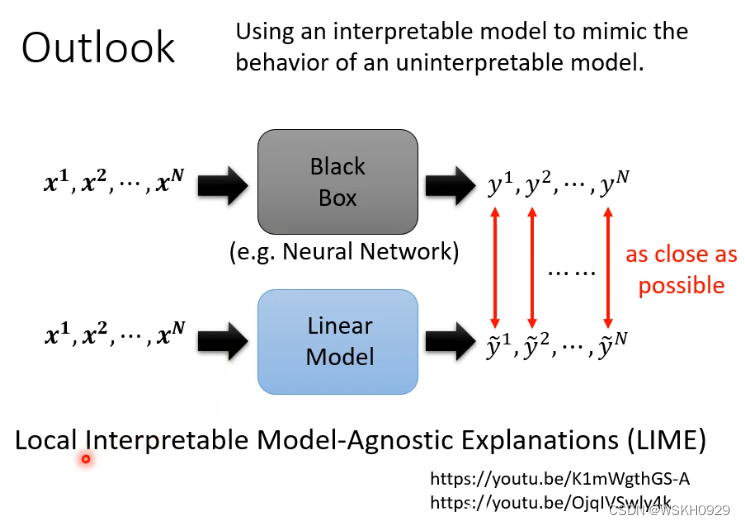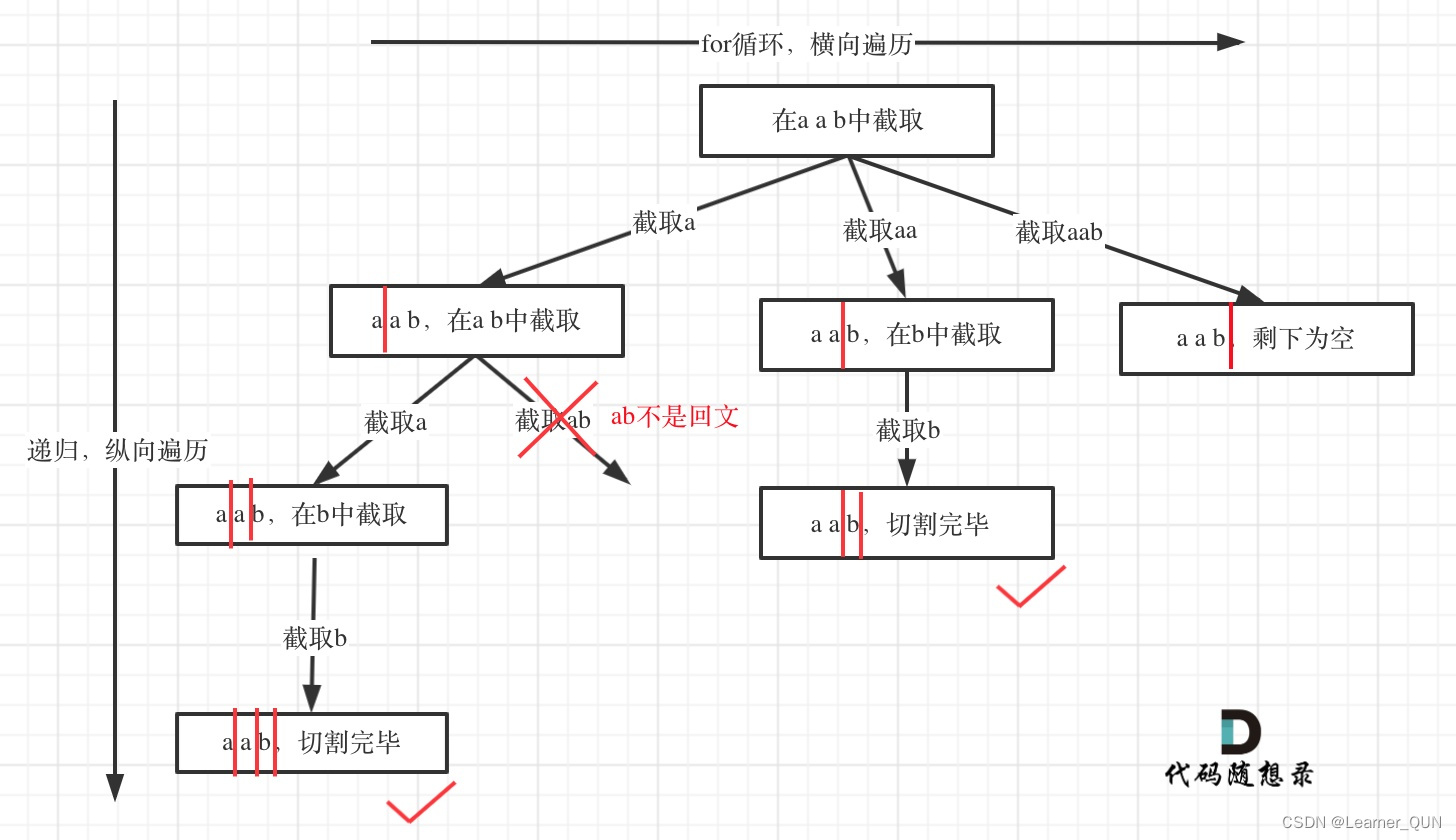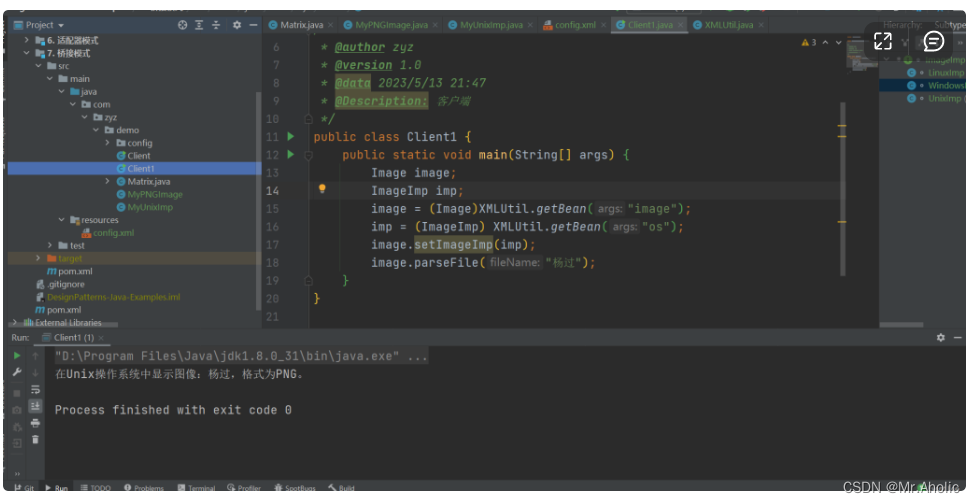示例
//@Component
@Configuration
public class AppConfig {
@Bean
public Foo foo() {
System.out.println("foo() invoked...");
Foo foo = new Foo();
System.out.println("foo() 方法的 foo hashcode: " + foo.hashCode());
return foo;
}
@Bean
public Eoo eoo() {
System.out.println("eoo() invoked...");
Foo foo = foo();
System.out.println("eoo() 方法的 foo hashcode: " + foo.hashCode());
return new Eoo();
}
public class Eoo {
}
public class Foo {
}
}
使用Configuration,日志输出
foo() invoked...
foo() 方法的 foo hashcode: 1150480094
eoo() invoked...
eoo() 方法的 foo hashcode: 1150480094
使用@Component,日志输出
foo() invoked...
foo() 方法的 foo hashcode: 1472494238
eoo() invoked...
foo() invoked...
foo() 方法的 foo hashcode: 1680147911
eoo() 方法的 foo hashcode: 1680147911
- 使用
@Configuration,方法之间互相调用获取到的是代理方法,不会重新生成新的Bean,foo方法返回的值和eoo方法中调用foo获取到的Foo对象是同一个。 - 使用
@Component,方法之间互相调用获取的是实际的方法,foo方法返回的值和eoo方法中调用foo获取到的Foo对象不是同一个。

【SpringBoot系列】SpringBoot中 @Configuration 和 @Component 的区别及原理分析【SpringBoot系列】SpringBoot中 @Configuration 和 @Component 的区别及原理分析【SpringBoot系列】SpringBoot中 @Configuration 和 @Component 的区别及原理分析
【SpringBoot系列】SpringBoot中 @Configuration 和 @Component 的区别及原理分析
【SpringBoot系列】SpringBoot中 @Configuration 和 @Component 的区别及原理分析
【SpringBoot系列】SpringBoot中 @Configuration 和 @Component 的区别及原理分析
原理解析
标注扫描类的代理模式
ConfigurationClassPostProcessor是做BeanDefinition扫描。扫描过程中,会执行ConfigurationClassUtils#checkConfigurationClassCandidate,获取BeanDefinition的类信息,判断是否存在Configuration,且注解上的属性proxyBeanMethods值不为false,设置属性CONFIGURATION_CLASS_FULL。@Configuration(proxyBeanMethods = false)和@Component一样效果,都是LITE模式。
public static boolean checkConfigurationClassCandidate(
BeanDefinition beanDef, MetadataReaderFactory metadataReaderFactory) {
String className = beanDef.getBeanClassName();
if (className == null || beanDef.getFactoryMethodName() != null) {
return false;
}
AnnotationMetadata metadata;
if (beanDef instanceof AnnotatedBeanDefinition &&
className.equals(((AnnotatedBeanDefinition) beanDef).getMetadata().getClassName())) {
// Can reuse the pre-parsed metadata from the given BeanDefinition...
metadata = ((AnnotatedBeanDefinition) beanDef).getMetadata();
}
else if (beanDef instanceof AbstractBeanDefinition && ((AbstractBeanDefinition) beanDef).hasBeanClass()) {
// Check already loaded Class if present...
// since we possibly can't even load the class file for this Class.
Class<?> beanClass = ((AbstractBeanDefinition) beanDef).getBeanClass();
if (BeanFactoryPostProcessor.class.isAssignableFrom(beanClass) ||
BeanPostProcessor.class.isAssignableFrom(beanClass) ||
AopInfrastructureBean.class.isAssignableFrom(beanClass) ||
EventListenerFactory.class.isAssignableFrom(beanClass)) {
return false;
}
metadata = AnnotationMetadata.introspect(beanClass);
}
else {
try {
MetadataReader metadataReader = metadataReaderFactory.getMetadataReader(className);
metadata = metadataReader.getAnnotationMetadata();
}
catch (IOException ex) {
if (logger.isDebugEnabled()) {
logger.debug("Could not find class file for introspecting configuration annotations: " +
className, ex);
}
return false;
}
}
Map<String, Object> config = metadata.getAnnotationAttributes(Configuration.class.getName());
if (config != null && !Boolean.FALSE.equals(config.get("proxyBeanMethods"))) {
beanDef.setAttribute(CONFIGURATION_CLASS_ATTRIBUTE, CONFIGURATION_CLASS_FULL);
}
else if (config != null || isConfigurationCandidate(metadata)) {
beanDef.setAttribute(CONFIGURATION_CLASS_ATTRIBUTE, CONFIGURATION_CLASS_LITE);
}
else {
return false;
}
// It's a full or lite configuration candidate... Let's determine the order value, if any.
Integer order = getOrder(metadata);
if (order != null) {
beanDef.setAttribute(ORDER_ATTRIBUTE, order);
}
return true;
}
ConfigurationClassPostProcessor#postProcessBeanFactory,扫描获取到所有的BeanDefinition,进行加强处理。
@Override
public void postProcessBeanFactory(ConfigurableListableBeanFactory beanFactory) {
int factoryId = System.identityHashCode(beanFactory);
if (this.factoriesPostProcessed.contains(factoryId)) {
throw new IllegalStateException(
"postProcessBeanFactory already called on this post-processor against " + beanFactory);
}
this.factoriesPostProcessed.add(factoryId);
if (!this.registriesPostProcessed.contains(factoryId)) {
// BeanDefinitionRegistryPostProcessor hook apparently not supported...
// Simply call processConfigurationClasses lazily at this point then.
processConfigBeanDefinitions((BeanDefinitionRegistry) beanFactory);
}
enhanceConfigurationClasses(beanFactory);
beanFactory.addBeanPostProcessor(new ImportAwareBeanPostProcessor(beanFactory));
}
ConfigurationClassPostProcessor#enhanceConfigurationClasses,所有的BeanDefinition获取属性ConfigurationClassUtils.CONFIGURATION_CLASS_ATTRIBUTE,如果等于ConfigurationClassUtils.CONFIGURATION_CLASS_FULL,存放到configBeanDefs。使用Cglib代理对@Configuration注解标注的类的增强。
public void enhanceConfigurationClasses(ConfigurableListableBeanFactory beanFactory) {
StartupStep enhanceConfigClasses = this.applicationStartup.start("spring.context.config-classes.enhance");
Map<String, AbstractBeanDefinition> configBeanDefs = new LinkedHashMap<>();
for (String beanName : beanFactory.getBeanDefinitionNames()) {
BeanDefinition beanDef = beanFactory.getBeanDefinition(beanName);
Object configClassAttr = beanDef.getAttribute(ConfigurationClassUtils.CONFIGURATION_CLASS_ATTRIBUTE);
AnnotationMetadata annotationMetadata = null;
MethodMetadata methodMetadata = null;
if (beanDef instanceof AnnotatedBeanDefinition) {
AnnotatedBeanDefinition annotatedBeanDefinition = (AnnotatedBeanDefinition) beanDef;
annotationMetadata = annotatedBeanDefinition.getMetadata();
methodMetadata = annotatedBeanDefinition.getFactoryMethodMetadata();
}
if ((configClassAttr != null || methodMetadata != null) && beanDef instanceof AbstractBeanDefinition) {
// Configuration class (full or lite) or a configuration-derived @Bean method
// -> eagerly resolve bean class at this point, unless it's a 'lite' configuration
// or component class without @Bean methods.
AbstractBeanDefinition abd = (AbstractBeanDefinition) beanDef;
if (!abd.hasBeanClass()) {
boolean liteConfigurationCandidateWithoutBeanMethods =
(ConfigurationClassUtils.CONFIGURATION_CLASS_LITE.equals(configClassAttr) &&
annotationMetadata != null && !ConfigurationClassUtils.hasBeanMethods(annotationMetadata));
if (!liteConfigurationCandidateWithoutBeanMethods) {
try {
abd.resolveBeanClass(this.beanClassLoader);
}
catch (Throwable ex) {
throw new IllegalStateException(
"Cannot load configuration class: " + beanDef.getBeanClassName(), ex);
}
}
}
}
if (ConfigurationClassUtils.CONFIGURATION_CLASS_FULL.equals(configClassAttr)) {
if (!(beanDef instanceof AbstractBeanDefinition)) {
throw new BeanDefinitionStoreException("Cannot enhance @Configuration bean definition '" +
beanName + "' since it is not stored in an AbstractBeanDefinition subclass");
}
else if (logger.isInfoEnabled() && beanFactory.containsSingleton(beanName)) {
logger.info("Cannot enhance @Configuration bean definition '" + beanName +
"' since its singleton instance has been created too early. The typical cause " +
"is a non-static @Bean method with a BeanDefinitionRegistryPostProcessor " +
"return type: Consider declaring such methods as 'static'.");
}
configBeanDefs.put(beanName, (AbstractBeanDefinition) beanDef);
}
}
if (configBeanDefs.isEmpty() || NativeDetector.inNativeImage()) {
// nothing to enhance -> return immediately
enhanceConfigClasses.end();
return;
}
ConfigurationClassEnhancer enhancer = new ConfigurationClassEnhancer();
for (Map.Entry<String, AbstractBeanDefinition> entry : configBeanDefs.entrySet()) {
AbstractBeanDefinition beanDef = entry.getValue();
// If a @Configuration class gets proxied, always proxy the target class
beanDef.setAttribute(AutoProxyUtils.PRESERVE_TARGET_CLASS_ATTRIBUTE, Boolean.TRUE);
// Set enhanced subclass of the user-specified bean class
Class<?> configClass = beanDef.getBeanClass();
Class<?> enhancedClass = enhancer.enhance(configClass, this.beanClassLoader);
if (configClass != enhancedClass) {
if (logger.isTraceEnabled()) {
logger.trace(String.format("Replacing bean definition '%s' existing class '%s' with " +
"enhanced class '%s'", entry.getKey(), configClass.getName(), enhancedClass.getName()));
}
beanDef.setBeanClass(enhancedClass);
}
}
enhanceConfigClasses.tag("classCount", () -> String.valueOf(configBeanDefs.keySet().size())).end();
}
代理核心
ConfigurationClassEnhancer#enhance,增强类
// The callbacks to use. Note that these callbacks must be stateless.
private static final Callback[] CALLBACKS = new Callback[] {
new BeanMethodInterceptor(),
new BeanFactoryAwareMethodInterceptor(),
NoOp.INSTANCE
};
private static final ConditionalCallbackFilter CALLBACK_FILTER = new ConditionalCallbackFilter(CALLBACKS);
public Class<?> enhance(Class<?> configClass, @Nullable ClassLoader classLoader) {
if (EnhancedConfiguration.class.isAssignableFrom(configClass)) {
if (logger.isDebugEnabled()) {
logger.debug(String.format("Ignoring request to enhance %s as it has " +
"already been enhanced. This usually indicates that more than one " +
"ConfigurationClassPostProcessor has been registered (e.g. via " +
"<context:annotation-config>). This is harmless, but you may " +
"want check your configuration and remove one CCPP if possible",
configClass.getName()));
}
return configClass;
}
Class<?> enhancedClass = createClass(newEnhancer(configClass, classLoader));
if (logger.isTraceEnabled()) {
logger.trace(String.format("Successfully enhanced %s; enhanced class name is: %s",
configClass.getName(), enhancedClass.getName()));
}
return enhancedClass;
}
private Enhancer newEnhancer(Class<?> configSuperClass, @Nullable ClassLoader classLoader) {
Enhancer enhancer = new Enhancer();
enhancer.setSuperclass(configSuperClass);
enhancer.setInterfaces(new Class<?>[] {EnhancedConfiguration.class});
enhancer.setUseFactory(false);
enhancer.setNamingPolicy(SpringNamingPolicy.INSTANCE);
enhancer.setStrategy(new BeanFactoryAwareGeneratorStrategy(classLoader));
enhancer.setCallbackFilter(CALLBACK_FILTER);
enhancer.setCallbackTypes(CALLBACK_FILTER.getCallbackTypes());
return enhancer;
}
ConfigurationClassEnhancer.BeanMethodInterceptor#isMatch,BeanMethodInterceptor拦截带有Bean注解的方法。
@Override
public boolean isMatch(Method candidateMethod) {
return (candidateMethod.getDeclaringClass() != Object.class &&
!BeanFactoryAwareMethodInterceptor.isSetBeanFactory(candidateMethod) &&
BeanAnnotationHelper.isBeanAnnotated(candidateMethod));
}
ConfigurationClassEnhancer.BeanMethodInterceptor#intercept,拦截方法,判断Bean是否正在创建,如果未创建,调用cglibMethodProxy.invokeSuper,否则调用resolveBeanReference。
@Override
@Nullable
public Object intercept(Object enhancedConfigInstance, Method beanMethod, Object[] beanMethodArgs,
MethodProxy cglibMethodProxy) throws Throwable {
ConfigurableBeanFactory beanFactory = getBeanFactory(enhancedConfigInstance);
String beanName = BeanAnnotationHelper.determineBeanNameFor(beanMethod);
// Determine whether this bean is a scoped-proxy
if (BeanAnnotationHelper.isScopedProxy(beanMethod)) {
String scopedBeanName = ScopedProxyCreator.getTargetBeanName(beanName);
if (beanFactory.isCurrentlyInCreation(scopedBeanName)) {
beanName = scopedBeanName;
}
}
if (factoryContainsBean(beanFactory, BeanFactory.FACTORY_BEAN_PREFIX + beanName) &&
factoryContainsBean(beanFactory, beanName)) {
Object factoryBean = beanFactory.getBean(BeanFactory.FACTORY_BEAN_PREFIX + beanName);
if (factoryBean instanceof ScopedProxyFactoryBean) {
// Scoped proxy factory beans are a special case and should not be further proxied
}
else {
// It is a candidate FactoryBean - go ahead with enhancement
return enhanceFactoryBean(factoryBean, beanMethod.getReturnType(), beanFactory, beanName);
}
}
if (isCurrentlyInvokedFactoryMethod(beanMethod)) {
if (logger.isInfoEnabled() &&
BeanFactoryPostProcessor.class.isAssignableFrom(beanMethod.getReturnType())) {
logger.info(String.format("@Bean method %s.%s is non-static and returns an object " +
"assignable to Spring's BeanFactoryPostProcessor interface. This will " +
"result in a failure to process annotations such as @Autowired, " +
"@Resource and @PostConstruct within the method's declaring " +
"@Configuration class. Add the 'static' modifier to this method to avoid " +
"these container lifecycle issues; see @Bean javadoc for complete details.",
beanMethod.getDeclaringClass().getSimpleName(), beanMethod.getName()));
}
return cglibMethodProxy.invokeSuper(enhancedConfigInstance, beanMethodArgs);
}
return resolveBeanReference(beanMethod, beanMethodArgs, beanFactory, beanName);
}
ConfigurationClassEnhancer.BeanMethodInterceptor#resolveBeanReference,获取Bean.
private Object resolveBeanReference(Method beanMethod, Object[] beanMethodArgs,
ConfigurableBeanFactory beanFactory, String beanName) {
boolean alreadyInCreation = beanFactory.isCurrentlyInCreation(beanName);
try {
if (alreadyInCreation) {
beanFactory.setCurrentlyInCreation(beanName, false);
}
boolean useArgs = !ObjectUtils.isEmpty(beanMethodArgs);
if (useArgs && beanFactory.isSingleton(beanName)) {
for (Object arg : beanMethodArgs) {
if (arg == null) {
useArgs = false;
break;
}
}
}
Object beanInstance = (useArgs ? beanFactory.getBean(beanName, beanMethodArgs) :
beanFactory.getBean(beanName));
if (!ClassUtils.isAssignableValue(beanMethod.getReturnType(), beanInstance)) {
// Detect package-protected NullBean instance through equals(null) check
if (beanInstance.equals(null)) {
if (logger.isDebugEnabled()) {
logger.debug(String.format("@Bean method %s.%s called as bean reference " +
"for type [%s] returned null bean; resolving to null value.",
beanMethod.getDeclaringClass().getSimpleName(), beanMethod.getName(),
beanMethod.getReturnType().getName()));
}
beanInstance = null;
}
else {
String msg = String.format("@Bean method %s.%s called as bean reference " +
"for type [%s] but overridden by non-compatible bean instance of type [%s].",
beanMethod.getDeclaringClass().getSimpleName(), beanMethod.getName(),
beanMethod.getReturnType().getName(), beanInstance.getClass().getName());
try {
BeanDefinition beanDefinition = beanFactory.getMergedBeanDefinition(beanName);
msg += " Overriding bean of same name declared in: " + beanDefinition.getResourceDescription();
}
catch (NoSuchBeanDefinitionException ex) {
// Ignore - simply no detailed message then.
}
throw new IllegalStateException(msg);
}
}
Method currentlyInvoked = SimpleInstantiationStrategy.getCurrentlyInvokedFactoryMethod();
if (currentlyInvoked != null) {
String outerBeanName = BeanAnnotationHelper.determineBeanNameFor(currentlyInvoked);
beanFactory.registerDependentBean(beanName, outerBeanName);
}
return beanInstance;
}
finally {
if (alreadyInCreation) {
beanFactory.setCurrentlyInCreation(beanName, true);
}
}
}

